Summary
Revista Brasileira de Ginecologia e Obstetrícia. 1999;21(3):171-174
DOI 10.1590/S0100-72031999000300009
In pregnant women with cervical incompetence in whom there is also dilatation of the cervix and prolapsed membranes there are technical difficulties in performing cerclage in order to prolongate pregnancy until sufficient fetal maturity assures survival of the newborn. We describe a case of cervical incompetence with prolapsed membranes at 21 weeks of gestation, in which we caused the decrease of intrauterine pressure with drainage of amniotic fluid by amniocentesis, until reintroduction of membranes into the uterine cavity was possible. This procedure allowed traction of cervical lips and cerclage with less mechanical trauma, warranting the evolution of pregnancy for 12 weeks and fetal survival
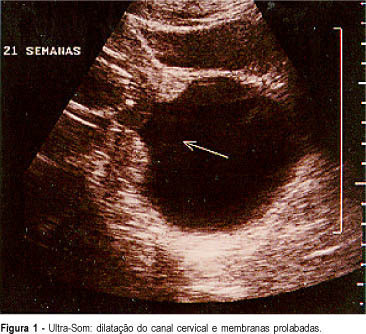
Summary
Revista Brasileira de Ginecologia e Obstetrícia. 2006;28(10):607-611
DOI 10.1590/S0100-72032006001000007
Cervical pregnancy is a rare condition in which the egg is implanted in the cervical canal causing it to distend as the egg grows. Cervical pregnancy constitutes less than 1% of all ectopic pregnancies. Painless hemorrhage is a habitual clinical characteristic and on physical examination a very vascularized hypertrophic cervix is observed with a tissue surpassing the external orifice. Ultrasonography may be used as a complementary diagnostic tool to show directly the presence of a gestational sac. A successful management of a viable seven-week gestation cervical pregnancy is reported herein. Feticide was performed with a single intraamniotic methotrexate injection (25 mg) guided by transvaginal ultrasonography. Systemic methotrexate in a single dose intramuscular (50 mg/m²) was associated. The conservative management of cervical ectopic pregnancy with methotrexate was effective and safe.
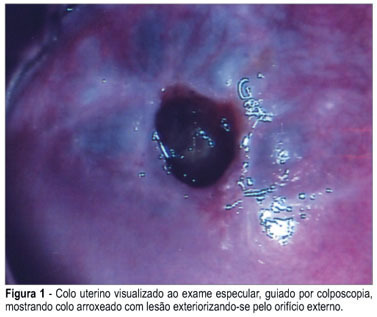
Summary
Revista Brasileira de Ginecologia e Obstetrícia. 2006;28(9):551-556
DOI 10.1590/S0100-72032006000900008
Premature ovarian failure may be idiopathic or associated with several autoimmune and genetic disorders as X chromosome deletions. We report two cases of preamture ovarian failure associated with a deletion in the long arm of X chromosome. Both patients were nulligravidas presenting secondary amenorrhea and complaints of infertility, without family history of premature ovarian failure and reporting normal puberal development. Their karyotypes showed deletions of the distal long arm of all X chromosomes and were 46,X, del(Xq22) and 46,X, del(Xq13q28), respectively. After the diagnosis the patients decided to be submitted to an in vitro fertilization with egg donation.

Summary
Revista Brasileira de Ginecologia e Obstetrícia. 2006;28(4):244-250
DOI 10.1590/S0100-72032006000400007
Osteogenesis imperfecta is a connective tissue disorder due to quantitative and qualitative anomalies in type 1 collagen, genetically transmitted by a dominant or recessive autosomal gene, leading to bone fragility. We report a case of a 19-year-old G1 PO patient referred to our institution following a screening ultrasound that demonstrated short limb fetal extremities. A level 3 scan was performed which evidenced an irregular cranial shape and compression of the cephalic pole with moderate transducer pressure. Limb shortening, decreased echoes and fractures of long bones were found on our scan evaluation. A vaginal delivery occurred at 35 weeks of gestation. The male newborn, weighing 1.990 grams had 6 and 8 in Apgar scores. The neonate was clearly abnormal, presenting irregular cranial shape, with poor ossification on X-ray, blue sclera, fractures and limb deformities. Postnatal evaluation was satisfactory and the neonate was discharged in good conditions. Prenatal diagnosis is important for an adequate pregnancy follow-up. Postnatal outcome was not related to vaginal delivery, as there were no recent fractures in the newborn.
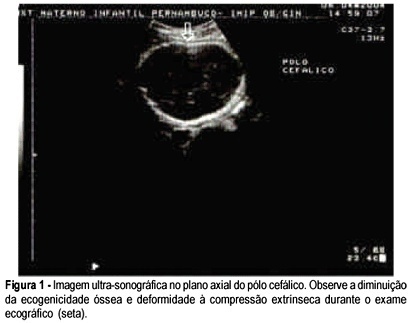
Summary
Revista Brasileira de Ginecologia e Obstetrícia. 1999;21(7):419-421
DOI 10.1590/S0100-72031999000700009
Squamous cell carcinoma of the mammary tissue is a very rare neoplasm, representing less than 1% of all breast carcinomas. The present study reports a case of squamous cell carcinoma of the breast, treated at the Hospital Araújo Jorge/ACCG. The tumor diagnosis, treatment and prognosis are also discussed.
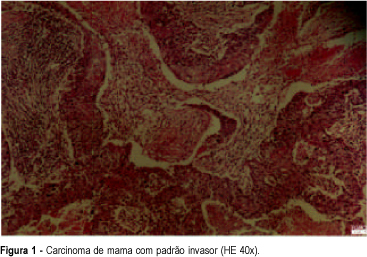
Summary
Revista Brasileira de Ginecologia e Obstetrícia. 1999;21(5):297-298
DOI 10.1590/S0100-72031999000500009
Endometrial ablation is a useful technique in patientes with abnormal uterine bleeding without response to clinical measures. Pregnancy is possible even after the destruction or resection of the endometrium. The case reported is a normal term pregnancy after endometrial ablation because ot menorrhagia without successful prior clinical treatment.
Summary
Revista Brasileira de Ginecologia e Obstetrícia. 1999;21(6):353-357
DOI 10.1590/S0100-72031999000600009
Introduction: meconium peritonitis as result of fetal intestinal perforation has a low incidence (1:30,000 deliveries) and high mortality (50% or more). Prenatal ultrasound findings include fetal ascites and intra-abdominal calcifications. Evidence suggests that prenatal diagnosis can improve postnatal prognosis. Case Report: R.C.M.S., 22 years, II pregnancy O para, presented ultrasound (12/02/98) with diagnosis of fetal ascites. Investigation for hydrops fetalis was performed and immune and nonimmune causes were excluded. Severe fetal ascites persisted on subsequent ultrasound examinations, without calcifications. Vaginal delivery occurred at 36 weeks (01/02/99), with polyhydramnios. Female neonate weighing 2,670 g, with signs of respiratory distress, abdominal distension and petechiae. Abdominal distension worsened progressively, with palpation of a petrous tumor in the right upper quadrant and elimination of white mucus at rectal examination. Radiological findings (01/04/99) were disseminated abdominal calcifications, intestinal dilatation and absence of gas at rectal ampulla. Exploratory laparotomy was indicated with diagnosis of meconium peritonitis. A giant meconium cyst and ileal atresia were observed and lysis of adhesions and ileostomy were performed. Initial postoperative evolution was satisfactory but was subsequently complicated by sepsis and neonatal death occurred (01/09/99). Conclusion: meconium peritonitis should be remembered at differential diagnosis of fetal ascites. In the present case, surgical indication could be anticipated if prenatal diagnosis were established, with improvement of neonatal evolution.
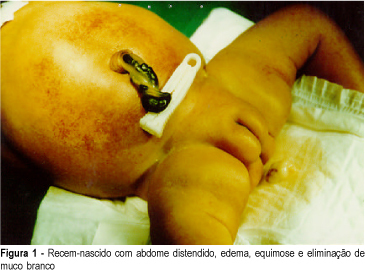
Summary
Revista Brasileira de Ginecologia e Obstetrícia. 1999;21(6):347-350
DOI 10.1590/S0100-72031999000600008
Purpose: to evaluate safety and efficacy of intra-amniotic injection of methotrexate (MTX) for treatment of viable cervical pregnancy. Methods: four women with viable cervical pregnancy confirmed by ultrasound (US) were treated with transvaginal injection of MTX (1 mg/kg) under sonographic control. The follow-up was made with serial dosages of beta-hCG on days 1, 4 and 7 after injection and weekly until the titers were negative. Results: the patients were treated with success. The time for the titers of beta-hCG to become negative after the treatment was: 62 days (case 1), 84 days (case 2), 28 days (case 3) and 10 days (case 4). Conclusion: intra-amniotic injection of MTX can be used to avoid surgery in cases of viable cervical pregnancy.